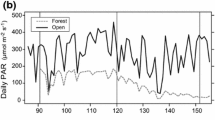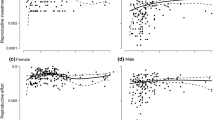Abstract
Stimulation of vegetative growth by an elevated CO2 concentration does not always lead to an increase in reproductive yield. This is because reproductive yield is determined by the fraction of biomass allocated to the reproductive part as well as biomass production. We grew Xanthium canadense at low N (LN) and high N levels (HN) under an ambient (360 μmol mol-1) and elevated (700 μmol mol-1) CO2 concentration ([CO2]) in open-top chambers. Reproductive yield was analysed as the product of: (1) the duration of the reproductive period, (2) the rate of dry mass acquisition in the reproductive period, and (3) the fraction of acquired biomass allocated to the reproductive part. Elevated [CO2] increased the total amount of biomass that was allocated to reproductive structures, but this increase was caused by increased capsule mass without a significant increase in seed production. The increase in total reproductive mass was due mainly to an increase in the rate of dry mass acquisition in the reproductive period with a delay in leaf senescence. This positive effect was partly offset by a reduction in biomass allocation to the reproductive part at elevated [CO2] and HN. The duration of the reproductive period was not affected by elevated [CO2] but increased by HN. Seed production was strongly constrained by the availability of N for seed growth. The seed [N] was very high in X. canadense and did not decrease significantly at elevated [CO2]. HN increased seed [N] without a significant increase in seed biomass production. Limited seed growth caused a reduction in biomass allocation to the reproductive part even though dry mass production was increased due to increased [CO2] and N availability.






Similar content being viewed by others
References
Ackerly DD, Bazzaz FA (1995) Plant growth and reproduction along CO2 gradients: non-linear responses and implications for community change. Global Change Biol 1:199–207
Allen LH Jr, Vu JCV, Valle RR, Boote KJ, Jones PH (1988) Nonstructural carbohydrates and nitrogen of soybean grown under carbon dioxide enrichment. Crop Sci 28:84–94
Andalo C, Godelle B, Lefranc M, Mousseau M, Till-Bottraud I (1996) Elevated CO2 decreases seed germination in Arabidopsis thaliana. Global Change Biol 2:129–135
Andalo C, Raquin C, Machon N, Godelle B, Mousseau M (1998) Direct and maternal effects of elevated CO2 on early root growth of germinating Arabidopsis thaliana seedlings. Ann Bot 81:405–411
Arp WJ (1991) Effects of source-sink relations on photosynthetic acclimation to elevated carbon dioxide. Plant Cell Environ 14:869–875
Badger M (1992) Manipulating agricultural plants for a future high CO2 environment. Aust J Bot 40:421–429
Bazzaz FA (1990) The response of natural ecosystems to the rising global CO2 levels. Annu Rev Ecol Syst 21:167–196
Bhattacharya S, Bhattacharya NC, Biswas PK, Strain BR (1985) Response of cowpea Vigna unguiculata to carbon dioxide enrichment environment on growth, dry-matter production and yield components at different stages of vegetative and reproductive growth. J Agric Sci 105:527–534
Craine JM, Reich PB (2001) Elevated CO2 and nitrogen supply alter leaf longevity of grassland species. New Phytol 150:397–403
Curtis PS, Wang X (1998) A meta-analysis of elevated CO2 effects on woody plant mass, form, and physiology. Oecologia 113:299–313
Epstein E (1972) Mineral nutrition of plants:principles and perspectives. Wiley, New York
Esashi Y, Leopold AC (1968) Physical forces in dormancy and germination of Xanthium seeds. Plant Physiol 43:871–876
Farnsworth EJ, Bazzaz FA (1995) Inter- and intra-generic differences in growth, reproduction, and fitness of nine herbaceous annual species grown in elevated CO2 environments. Oecologia 104:454–466
Field CB, ChapinIII FS, Matson PA, Mooney HA (1992) Responses of terrestrial ecosystems to the changing atmosphere: a resource-based approach. Annu Rev Ecol Syst 23:201–235
Garbutt K, Bazzaz FA (1984) The effects of elevated carbon dioxide on plants. 3. Flower, fruit and seed production and abortion. New Phytol 98:433–446
Garbutt K, Williams WE, Bazzaz FA (1990) Analysis of the differential response of five annuals to elevated carbon dioxide during growth. Ecology 71:1185–1194
Hare JD, Futuyma DJ (1978) Different effects of variation in Xanthium strumarium L. (Compositae) on two insect seed predators. Oecologia 37:109–120
Hikosaka K, Hirose T (2001) Nitrogen uptake and use by competing individuals in a Xanthium canadense stand. Oecologia 126:174–181
Hirose T, Ackerly DD, Traw MB, Bazzaz FA (1996) Effects of CO2 elevation on canopy development in the stands of two co-occurring annuals. Oecologia 108:215–223
Huxman TE, Hamerlynck EP, Jordan DN, Salsman KJ, Smith SD (1998) The effects of parental CO2 environment on seed quality and subsequent seedling performance in Bromus rubens. Oecologia 114:202–208
Huxman TE, Hamerlynck EP, Smith SD (1999) Reproductive allocation and seed production in Bromus madritensis ssp. rubens at elevated atmospheric CO2. Funct Ecol 13:769–777
Jablonski LM, Wang X, Curtis PS (2002) Plant reproduction under elevated CO2 conditions: a meta-analysis of reports on 79 crop and wild species. New Phytol 156:9–26
Kader AA (1986) Biochemical and physiological basis for effects of controlled and modified atmospheres on fruits and vegetables. Food Technol 40:99–104
Kim GH, Wills RBH (1995) Effect of ethylene on storage life of lettuce. J Sci Food Agric 69:197–201
Kimball BA, Kobayashi K, Bindi M (2002) Responses of agricultural crops to free-air CO2 enrichment. Adv Agron 77:293–368
Lambers H, Poorter H (1992) Inherent variation in growth rate between higher plants:a search for physiological causes and ecological consequences. Adv Ecol Res 23:187–261
Larigauderie A, Hilbert DW, Oechel WC (1988) Effect of carbon dioxide enrichment and nitrogen availability on resource acquisition and resource allocation in a grass Bromus mollis. Oecologia 77:544–549
Leishman MR, Sanbrooke KJ, Woodfin RM (1999) The effects of elevated CO2 and light environment on growth and reproductive performance of four annual species. New Phytol 144:455–462
Makino A, Mae T (1999) Photosynthesis and plant growth at elevated levels of CO2. Plant Cell Physiol 40:999–1006
Makino A, Harada M, Sato T, Nakano H, Mae T (1997) Growth and N allocation in rice plants under CO2 enrichment. Plant Physiol 115:199–203
McConnaughay KDM, Berntson GM, Bazzaz FA (1993) Limitations to CO2 induced growth enhancement in pot studies. Oecologia 94:550–557
McMillan C (1974) Photoperiodic adaptation of Xanthium strumarium in Europe, Asia Minor, and northern Africa. Can J Bot 52:1779–1791
Nagashima H, Yamano T, Hikosaka K, Hirose T (2003) Effects of elevated CO2 on the size structure in even-aged monospecific stands of Chenopodium album. Global Change Biol 9:619–629
Parrish JAD, Bazzaz FA (1985) Nutrient content of Abutilon theophrasti seeds and the competitive ability of the resulting plants. Oecologia 65:247–251
Poorter H (1993) Interspecific variation in the growth response of plants to an elevated ambient CO2 concentration. Vegetatio 104:77–97
Ray P, Alexander W (1966) Photoperiodic adaptation to latitude in Xanthium strumarium. Am J Bot 53:806–816
Reekie EG, Bazzaz FA (1991) Phenology and growth in four annual species grown in ambient and elevated carbon dioxide. Can J Bot 69:2475–2481
Reekie JYC, Hicklenton PR, Reekie EG (1994) Effects of elevated CO2 on time of flowering in four short-day and four long-day species. Can J Bot 72:533–538
Rogers GS, Payne L, Milham P, Conroy J (1993) Nitrogen and phosphorus requirements of cotton and wheat under changing atmospheric CO2 concentrations. Plant Soil 155/156:231–234
Sage RF (1994) Acclimation of photosynthesis to increasing atmospheric CO2: the gas exchange perspective. Photosynth Res 39:351–368
Shitaka Y, Hirose T (1993) Timing of seed germination and the reproductive effort in Xanthium canadense. Oecologia 95:334–339
Shitaka Y, Hirose T (1998) Effects of shift in flowering time on the reproductive output of Xanthium canadense in a seasonal environment. Oecologia 114:361–367
Sorensen AE (1986) Seed dispersal by adhesion. Annu Rev Ecol Syst 17:443–463
St Omer L, Horvath SM (1983) Elevated carbon dioxide concentrations and whole plant senescence. Ecology 64:1311–1314
Steinger T, Gall R, Schmid B (2000) Maternal and direct effects of elevated CO2 on seed provisioning, germination and seedling growth in Bromus erectus. Oecologia 123:475–480
Stitt M, Krapp A (1999) The interaction between elevated carbon dioxide and nitrogen nutrition: the physiological and molecular background. Plant Cell Environ 22:583–621
Sugiyama H, Hirose T (1991) Growth schedule of Xanthium canadense: does it optimize the timing of reproduction? Oecologia 88:55–60
Sylvestre I, Droillard MJ, Bureau JM, Paulin A (1989) Effects of the ethylene rise on the peroxidation of membrane lipids during the senescence of cut carnations. Plant Physiol Biochem 27:407–414
Tissue DT, Thomas RB, Strain BR (1993) Long-term effects of elevated CO2 and nutrients on photosynthesis and rubisco in loblolly pine seedlings. Plant Cell Environ 16:859–865
Ward JK, Strain BR (1997) Effects of low and elevated CO2 partial pressure on growth and reproduction of Arabidopsis thaliana from different elevations. Plant Cell Environ 20:254–260
Ward JK, Strain BR (1999) Elevated CO2 studies:past, present and future. Tree Physiol 19:211–220
Wong SC, Kriedemann PE, Farquhar GD (1992) CO2×nitrogen interaction on seedling growth of four species of Eucalypt. Aust J Bot 40:457–472
Zak DR, Pregitzer KS, Curtis PS, Vogel CS, Holmes WE, Lussenhop J (2000) Atmospheric CO2, soil-N availability, and allocation of biomass and nitrogen by Populus tremuloides. Ecol Appl 10:34–46
Ziska LH, Weerakoon W, Namuco OS, Pamplona R (1996) The influence of nitrogen on the elevated CO2 response in field-grown rice. Aust J Plant Physiol 23:45–52
Acknowledgements
We thank K. Sato, H. Nagashima, Y. Shitaka, B. Geng, T. Yamano and Y. Onoda for advise and help in the experiment and N. P. R. Anten and O. Muller for comments on an earlier draft. This work was supported in part by grants-in-aid from the Japan Ministry of Education, Science and Culture.
Author information
Authors and Affiliations
Corresponding author
Rights and permissions
About this article
Cite this article
Kinugasa, T., Hikosaka, K. & Hirose, T. Reproductive allocation of an annual, Xanthium canadense, at an elevated carbon dioxide concentration. Oecologia 137, 1–9 (2003). https://doi.org/10.1007/s00442-003-1318-0
Received:
Accepted:
Published:
Issue Date:
DOI: https://doi.org/10.1007/s00442-003-1318-0




